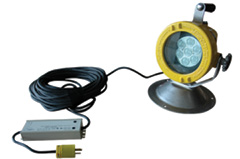Confined spaces, such as storage silos, reclaim tunnels and storage tanks, and wet locations, including wastewater treatment plants and wash-down facilities, are some of the toughest work environments to operate in for businesses in industrial sectors. Minimizing risks through the deployment of explosion proof fixtures (for hazardous locations) and low voltage luminaries are vital to ensuring workplace safety.
The latter lighting system is defined as fixtures that operate below 50V, typically 24V or 12V – sometimes lower. These special units are closely regulated by MSHA, OSHA and the NFPA, due to their ability to reduce the intensity of electrocution when exposed to live body parts – thus, increasing the chances of survival upon contact with the electrical component. Shock from a low voltage light may throw the operator off balance, as opposed to severe burns and uncontrollable shaking, which could easily lead to serious injury or death.
By nature, confined spaces are extremely limited; and implementing the above guidelines may be difficult for businesses. Because of such obstacles, the most direct and safest path to compliance is the use of low voltage lights, which includes the following:
- Corded Confined Space Lights: These units may be explosion proof or approved for wet locations. During operation, the luminary is connected to a power supply or transformer with an input cord connecting to a 120VAC source. The power supply or transformer (located outside of the confined space) steps down the voltage to the low-voltage requirement of the light (located inside the confined space).
- Cordless Confined Space Lights: Examples of such units include intrinsically safe flashlights, explosion proof hand lamps and handheld spot lights. Power supply comes from a battery pack (not a corded power source).
- 120V Lights with GFCI Protection: Alternatively, operators may also use confined space lighting approved for wet locations at 120V, as long as it is reinforced with a GFCI protected plug. In the event of a potential hazard, the component offers protection from electrical shock.
For businesses, investing in low voltage lights may help reduce costs associated with training. Since most low voltage lights operate below 24V, employers do not have to waste time and money on classroom or on-the-job training programs to operate such luminaries.
Larson Electronics, www.larsonelectronics.com, 800-369-6671

